How to Harvest & Preserve Red Raspberry Leaf Tea
This post may contain affiliate links, which means that I may receive a commission if you make a purchase using these links. As an Amazon Associate I earn from qualifying purchases.
Red raspberry leaf is a delicious herb with a taste similar to green tea. See how to harvest, dehydrate, and brew raspberry leaf tea.
Red raspberry leaf tea has been used for centuries as a natural remedy for conditions involving the uterus including pregnancy, childbirth, menstruation, and menopause. See how to harvest and preserve your own raspberry leaf tea.
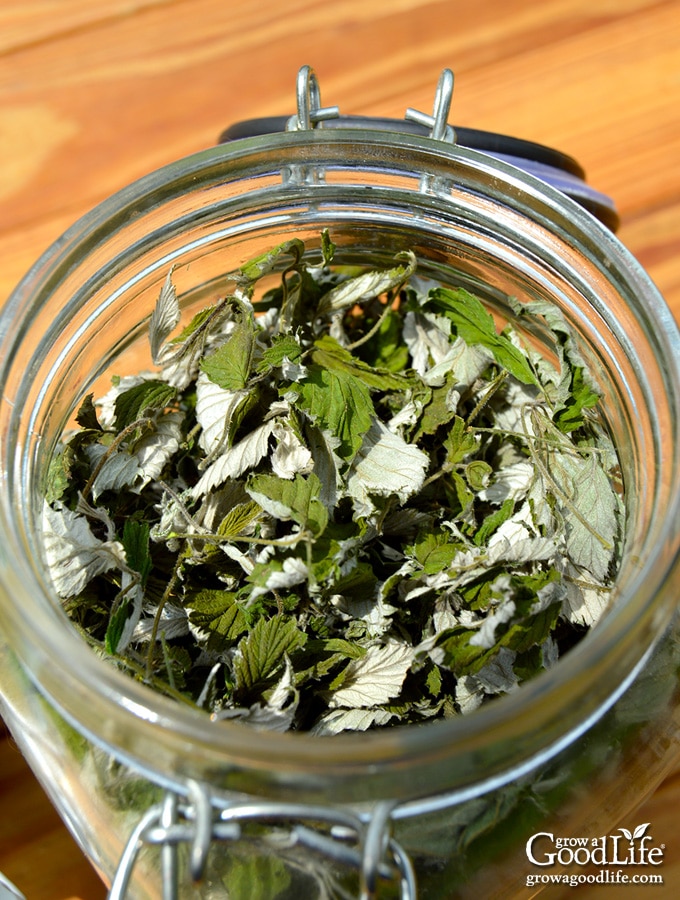
When I planted raspberries (Rubus idaeus) on the property back in 2010 it was for the delicious fruit. It was years later while researching natural remedies to ease my menstrual symptoms that I discovered that red raspberry leaf tea is a natural remedy for conditions involving the uterus, including menstrual support and menopause (Native American Medicinal Plants).
Red raspberry leaves have also been used as medicine for centuries for pregnancy and childbirth, astringent for skin irritations, gargle for sore throats, and for diarrhea. Raspberry leaf tea has no known side effects or drug interactions, but it can lower blood sugar and impede with the absorption of some vitamins (Healing Herbs A to Z).
It is not known precisely why Raspberry Leaf tea is so effective for uterine health. Herbalists believe that the presence of tannins and the alkaloid fragarine combined with other nutrients, including calcium, iron, phosphorus, potassium, and vitamin B, C, and E help tone and relax the pelvic and uterine muscles (Herbal Healing for Women).
After researching, I felt pretty confident in trying red raspberry leaf tea for my menstrual discomforts, and I had plenty of access to leaves to harvest. After drinking red raspberry tea for several months, it relieved a lot of my symptoms, including headache, cramps, and overall energy level and moodiness during that time of the month.
I wasn’t completely convinced until I casually remarked to Kevin that I thought the red raspberry leaf tea was helping. The next thing I knew, he was outside in the raspberry patch harvesting more raspberry leaves for me to use. Hmmm….
How to Harvest, Dry, and Brew Raspberry Leaf Tea
Step 1: Collect raspberry leaves before the plant blooms
Harvest mid-morning after the dew has evaporated and before it the sun is hot to preserve the oils and flavor. Wear gloves and long sleeves to protect yourself from the thorns.
Like most herb, once the plant begins to bloom, the leaves turn bitter. Select young, healthy leaves that have not been treated with chemicals or eaten by bugs, and clip them from the cane.
I grow Heritage raspberries, an everbearing variety that produces two crops each season, a light crop in July followed by a heavy crop in fall. I allow the canes to begin leafing out before pruning the raspberry patch in the spring. I cut whole canes and trim the young leaves off into a large bowl as I prune.
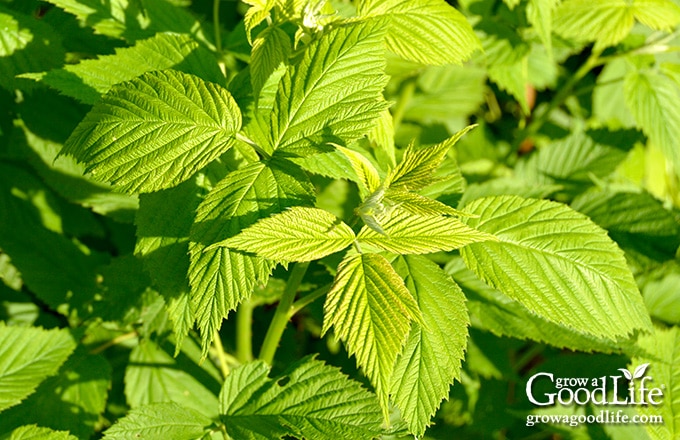
Step 2: Dry the raspberry leaves
You can either let the leaves dry naturally, or use a dehydrator to dry the raspberry leaves quicker. First, wash the leaves well with running water to remove dust and insects and lay them out on a kitchen towel to let some of the moisture evaporate. Then decide how you are going to dry the raspberry leaves:
Let the Raspberry Leaves Dry Naturally: Spread the leaves out on a screen and allow them to dry naturally away from dust and sunlight. Or you can gather the leaves by their stems, tie the ends, and hang them to dry. Depending on the humidity, drying usually takes 1-2 weeks.
Use a Dehydrator to Dry the Raspberry Leaves: The quickest way to dry raspberry leaves is by using a dehydrator. Spread the leaves out on the screens and dry at a low temperature. Check every 30-minutes until completely dry.
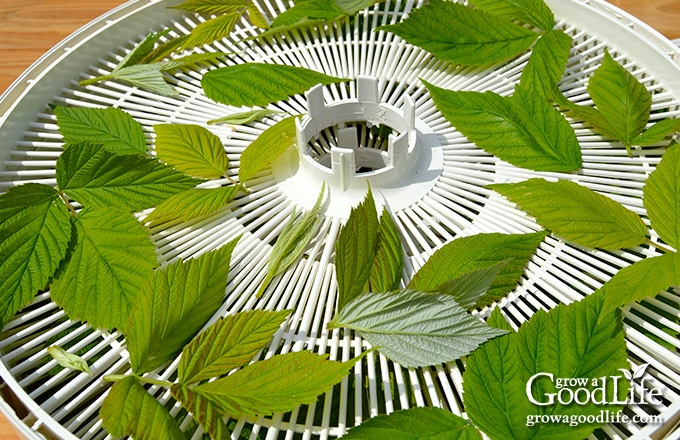
Step 3: Store dehydrated raspberry leaves
You can tell when the leaves are dry, by crushing a leaf or two. It should crumble easily. Once the leaves are dry, store leaves lightly packed in a glass jar away from direct sunlight. Try not to crush them to reserve the flavor until you are ready to brew your tea.
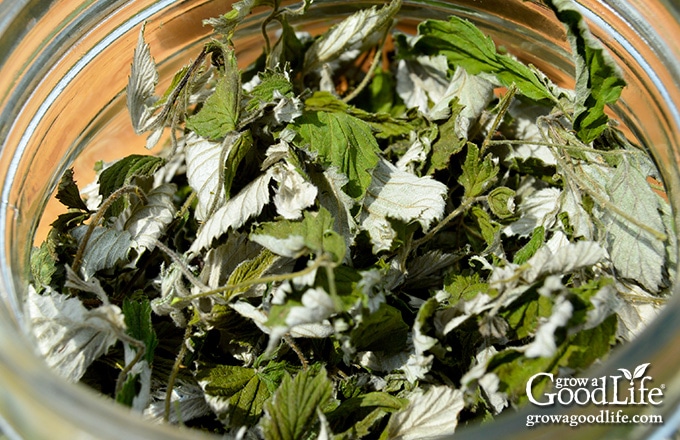
Step 4: Brewing raspberry leaf tea
Red raspberry leaf tea tastes like a mild green tea, but without the caffeine. To make the tea, use about 1-teaspoon of crushed, dried raspberry leaves per 8-ounce cup of boiling water. Steep for at least 5 minutes and drink like regular tea.

![]()
Want to learn how to use herbs as medicine? Check out the online courses at The Herbal Academy of New England: Introductory Herbal Course and Intermediate Herbal Course.
![]()
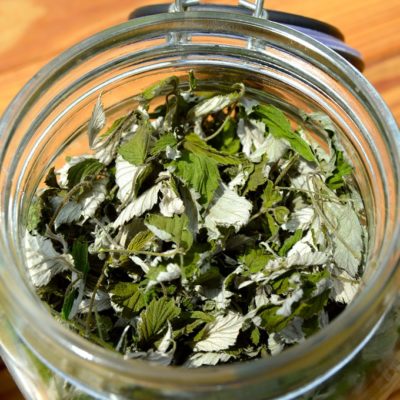
How to Preserve Red Raspberry Leaf Tea
Ingredients
- 1 bunch fresh raspberry leaves
- twine drying screen or food dehydrator
- 1 glass jar for storing
Instructions
- Gather young raspberry leaves.
- Wash the leaves well with running water to remove dust and insects and lay them out on a kitchen towel to let some of the moisture evaporate.
Dry the Raspberry Leaves
- You can either let the leaves dry naturally, or use a food dehydrator to dry the raspberry leaves quicker. First, Then decide how you are going to dry the raspberry leaves:
- Hang and Air Dry: Remove the lower leaves, tie the stems into small bundles, and hang upside down in a dry.
- Drying Screen: Spread the leaves out on a drying screen. Suspend the screen over two chairs so the air can circulate above and below the screen.
- Food Dehydrator: Preheat food dehydrator to 100˚F. Place the herbs in a single layer on dehydrator trays and place in the dehydrator until herbs are dry, 1 to 4 hours depending on the type of herb. Check every 30 minutes to prevent over drying.
- Once the leaves are dry, store lightly packed in a glass jar away from direct sunlight. Try not to crush them to reserve the flavor until you are ready to brew your tea.
- Store the jars in a in a cool, dark place, away from heat, humidity, and temperature fluctuations. Dried herbs will remain potent for 6 to 12 months when stored properly.
- To brew the tea, use about 1-teaspoon of crushed, dried raspberry leaves per 8-ounce cup of boiling water. Steep for at least 5 minutes and drink like regular tea.
Nutrition
Resources and Further Reading:
- Moerman, Daniel E. Native American Medicinal Plants. Portland, OR: Timber Press, 1998.
- Gladstar, Rosemary. Herbal Healing for Women. New York, NY: Touchstone, 1993.
- Stein, Diane. Healing Herbs A to Z: A Handy Reference to Healing Plants. Berkeley, CA: Ten Speed Press, 2009.
- White, Linda B. and Steven Foster. The Herbal Drugstore. Emmaus, PA: Rodale, 2003.
- Purchase Raspberry Leaf Tea from Starwest Botanicals on Amazon.
I am not a doctor and the statements on this website have not been evaluated by the FDA. It is recommended that you consult your medical care provider or herbalist prior taking or relying upon any herbal product.
You May Also Like These Herb Articles:
Good planning is key to a successful vegetable garden
Whether you are new to growing your own food or have been growing a vegetable garden for years, you will benefit from some planning each year. You will find everything you need to organize and plan your vegetable garden in my PDF eBook, Grow a Good Life Guide to Planning Your Vegetable Garden.


Wow, this is amazing! I have recently learned about the benefits of raspberry leaf tea and have raspberry plants in my backyard…I can’t wait until they start growing in the spring so I can use your tips to harvest the leaves. Thank you for the GREAT information!!
Do you know if you can make tea from ALL red raspberry plants or only certain types?
Laura, I understand your excitement. I was thrilled that I had such a easy remedy right in my back yard. Any raspberry plant in the Rubus idaeus family can be used.
What a great idea – I can’t wait to do this with my raspberry bushes.
Thanks for the informative post.
I share information about Red Raspberry leaf tea with my post partum doula clients. And I always have some on hand for my own family.
Thanks for such an interesting and well done post at Wildcrafting Wednesday. Congrats on being a featured blogger.
Congratulations on being chosen as a Featured Post on Wildcrafting Wednesday #185!
What an excellent tutorial! I am so delighted that you shared your informative and valuable insights on How to Harvest & Preserve Red Raspberry Leaf Tea with us at the Healthy Happy Green and Natural Party Blog Hop. I’m pinning and sharing.
What a great informative post, we are just about to plant raspberries, so this will come in very handy. Thanks for sharing at Good Morning Mondays. Blessings
I have always bought my red raspberry leaf tea…it really never occurred to me to harvest my own! Thanks for the info!
Thanks for linking up with Green Thumb Thursday. I hope you’ll join us again this week!
Lisa
Oh I didn’t realise all these health benefits of raspberry tea. Sounds wonderful. I will be sure to drink some of this now!!
Thanks for sharing at Marvelous Monday on Smart Party Planning.